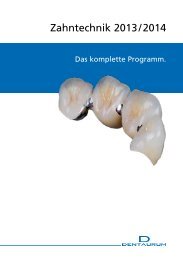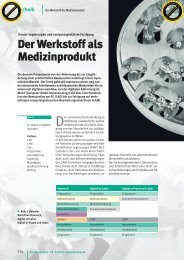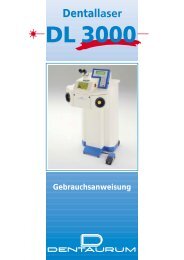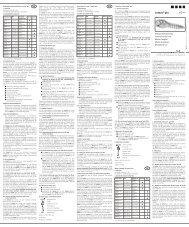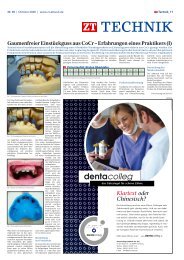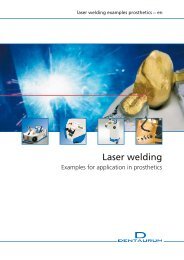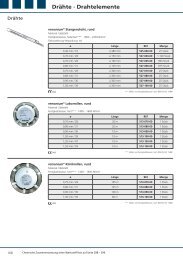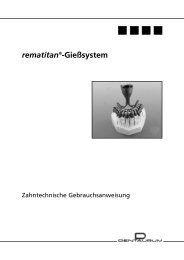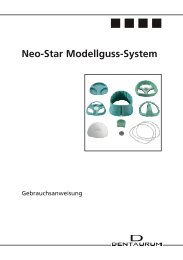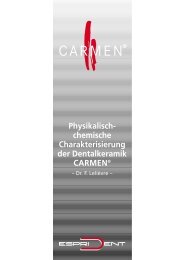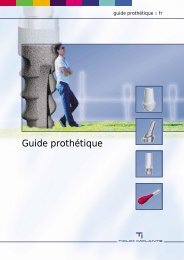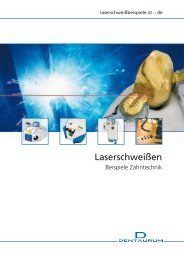remanium® K+B Gebrauchsanweisung - DENTAURUM
remanium® K+B Gebrauchsanweisung - DENTAURUM
remanium® K+B Gebrauchsanweisung - DENTAURUM
Create successful ePaper yourself
Turn your PDF publications into a flip-book with our unique Google optimized e-Paper software.
EN<br />
EN<br />
17. Oxide firing<br />
Oxidation firing is not required with remanium ® bonding alloys. It is advisable to fire an oxide<br />
bake in order to visually check the framework condition (5 minutes without vacuum at the firing<br />
temperature of the opaque, unless otherwise indicated by the ceramic manufacturer). Following<br />
the bake, the oxide should be removed by blasting with single use aluminium oxide abrasive,<br />
grain size 125 µm and low pressure of 2 – 3 bar. Afterwards the surface must be cleaned again.<br />
18. Ceramic veneering<br />
remanium ® ceramic bonding alloys can be veneered using conventional ceramics such as<br />
Carmen ® or CCS (Dentaurum) as long as the CTE is suitable with the alloy (see alloy info<br />
supplement).<br />
The coefficient of thermal expansion (CTE) of many ceramic varieties increases, depending on<br />
the amount of times the ceramic is fired and the length of time within the firing furnace.<br />
The longer and the more often the ceramic is fired, the higher the CTE. The metal CTE<br />
remains constant; the adhesion takes place by applying cooling times after firing and standby<br />
temperatures.<br />
The opaque material can be applied to the sandblasted and cleaned metal framework<br />
according to the ceramic manufacturer’s recommendation.<br />
It is important to dry the opaque thoroughly. Always ensure the ceramic furnace is calibrated!<br />
The ceramic is then applied according to the instructions for use!<br />
If no other information is given by the ceramic manufacturer, the object is cooled as<br />
recommended in the alloy info supplement.<br />
Important: After each firing, brush the framework under running water and allow<br />
it to dry.<br />
19. Soldering<br />
Try to avoid soldering if possible in order to prevent a material mixture. If however, it is<br />
necessary to solder, please ensure a suitable solder with the correct composition and melting<br />
temperature which is appropriate for the alloy used.<br />
Roughen the joint areas with fine corundum stones.<br />
Connect the parts using wax or acrylic, remove from the dies and fix in investment material for<br />
soldering. Boil out. Apply a coat of flux to the solder joint areas. Allow the model to dry, then<br />
preheat at 600 °C / 1112 °F for 10 min. Apply a further coating of flux and heat the casting<br />
until it is red hot. Cut the solder to the appropriate length, dip the pieces into the flux and<br />
place them into the soldering gap. The flux on the piecesof solder and soldering gap must be<br />
heated with a hot flame until it covers the joint area completely. Only then bring the solder to<br />
flow through the hot flame.<br />
Caution: Soldered units should cool slowly after the ceramic has been fired.<br />
19.1. Soldering after firing<br />
It is not recommended to solder after having applied the ceramic. The reason for this is that<br />
the corrosive resistance is reduced and the low diffusion ability of precious metal solders to<br />
non-precious alloys. Recommended alternatives are joining techniques such as laser welding,<br />
WIG welding and adhesive joining.<br />
20. Laser welding<br />
The laser welding technique produces a solder-free, mechanically strong and corrosion<br />
resistant joint.<br />
It is important to observe the framework design, the surface structures, the welding sequence<br />
and the welding parameter of each individual laser machine. Suitable welding material is laser<br />
welding wire in the same metal as the remanium ® crown and bridge alloy.<br />
21. Cleaning<br />
Crowns and bridgework made in remanium ® crown and bridge alloys can be cleaned, after<br />
finishing, with ultrasonic solution P.<br />
22. Contraindications and side effects<br />
Signs of intolerance to non-precious remanium ® crown and bridge alloys after are rare<br />
correct processing.<br />
If the patient has a proven allergy against any component within the alloy, for safety reasons<br />
this alloy must not be used.<br />
If various alloys have been used, it is possible that galvanic effects may occur.<br />
Some patient have shown traces of local irritation caused by electrochemical reactions.<br />
20 remanium ® crowns and bridges en<br />
remanium ® crowns and bridges en 21



